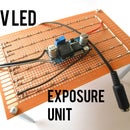Introduction: Electronic Dice With Slowdown - 555 & 4017
Have your dice ever fallen off the table after you rolled them when playing a board game? Yes? Say no more because in this instructable I will show you how I made electronic dice with the famous integrated circuits 555 timer and 4017 johnson counter!
Step 1: Demonstration
I found these cheap chinese ebay kits and thought that some people might be interested in their schematic or PCB therefore I "cloned" their PCB so that anyone can make it themselves. Oh and I manage to do so without buying any of their kits, just from the pictures.
Step 2: Parts List
For this instructable you will need:
Electronic Dice PCB or perfboard
1x - 4017 johnson counter
1x - 555 timer
2x - BC557 or any other small signal PNP transistor
3x - BC547 or any other small signal NPNtransistor
6x - 5MM LED
1x - 1N4148 or any other general purpose diode
1x - tactile switch
1x - 9V battery clip (6f22)
1x - 3AA battery holder
1x - 1µF electrolytic capacitor
1x - 100nF ceramic capacitor
3x - 470Ω resistor
1x - 1kΩ resistor
9x - 10kΩ resistor
1x - 3.3MΩ resistor
1x - 4.7MΩ resistor
1x - 10MΩ resistor
Optional:
1x - 16pin DIP socket
1x - 8pin DIP socket
Step 3: Schematic and PCB
This circuit has to be powered by approximately 5V in order to work properly. 9V battery didn't work for me. This circuit offers plenty of features for the amount of components it consists of. I think that there are no more features needed(correct me if I'm wrong).
To make the schematic and the PCB I used a free program Cadsoft Eagle which I would recommend to anyone making schematics or PCBs.
Step 4: Etching the PCB
I did not make the video.
I etched the PCB with i guess "photographic method" - that would be the direct translation from my language. I printed out the PDF file from previous step on transparent foil and then shone through it on photosensitve PCB, then developed it in solution of sodium hydroxide and then etched it in ferric chloride. If you find it confusing just watch the video, It's very well explained. Also don't forget to orient the transparent foil on the PCB so that you can read the words written on it.
Step 5: Conclusion
Now you should have all the knowledge necessary to build your own Electronic Dice. Good luck and don't forget to post your results into the comments.















